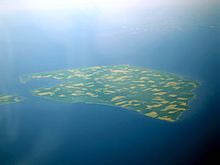Fehmarnbelt (nature reserve)

The Fehmarnbelt is a nature reserve in the German exclusive economic zone in the Baltic Sea . The area is also a marine protected area of the European Commission designated by the Federal Agency for Nature Conservation as an FFH area .
Geography, geology and hydrology
The approximately 280 km² large protected area is located in front of the Baltic Sea island of Fehmarn . It comprises the narrow German exclusive economic zone north of the island with the Fehmarnbelt channel. The channel is a strait up to 35 m deep, through which about 70 percent of the water exchange between the North and Baltic Seas takes place. As a result, this strait has an important key function for the distribution and exchange of marine species.
The south of the Fehmarnbelt is characterized by large, several meters high sand ripples on the sea floor . These so-called “megaripples” with a crest height of up to 3 m represent a special characteristic of the FFH habitat type “sandbanks”. Due to their rarity, they are of particular geoscientific and ecological value. Its origin has not yet been conclusively clarified. They are populated by heterogeneous benthic communities on a small scale , for which u. a. Astartemuscheln and Iceland shells are characteristic.
fauna and Flora
The reefs in the protected area are home to some of the most biodiverse communities in the Baltic Sea and are populated with brown and red algae in water depths of over 20 m . These extensive algae stocks are an essential feature of the reefs in the Fehmarnbelt. The benthic communities growing on the stones are very species-rich and are determined by numerous species of sponges and mussels. Very sensitive (including various types of cancer) and z. Sometimes long-lived species such as whelks and common spindle snails indicate constant and good environmental conditions. Researchers recently discovered species in all large groups that had not been found in the Baltic Sea for years or decades. A large part of the benthic organisms listed in the “ Red List of Endangered Species of the German Baltic Sea” could be detected in the protected area.
Harbor porpoises swim through the Fehmarnbelt regularly on their migrations and very often for Baltic Sea conditions. They occur both in the nature reserve and in the immediately surrounding waters around Fehmarn (especially Westfehmarn and Southwest Fehmarn towards the Bay of Kiel ). The area seems to have an important meaning for the animals, for example during their resting phases. Calves have also been spotted as part of studies. Since 2002 harbor porpoises have been counted in the German Baltic Sea using aircraft recordings from the West Coast Research and Technology Center and recorded acoustically with the help of Porpoise Click Detectors (PODs, underwater microphones that record the porpoise sounds (clicks)). Several PODs are firmly anchored around Fehmarn. In addition, the migratory movements of porpoises as far as the Fehmarnbelt were recorded by Danish researchers.
As a further Annex II type of the Habitats Directive, the few seals in the southern Baltic Sea that use the area for foraging are also protected.
Expulsion, protection and care
The area, together with four other marine protected areas, was registered in 2006 by the Federal Agency for Nature Conservation (BfN) as an FFH area to Brussels. This was preceded by lengthy and extensive investigations of the area, related to the benthos geology, flora and fauna and hydrological aspects ( salinity , river currents, etc.). The technical support is taken over by the BfN as a federal authority, but a number of other research institutions (FTZ West Coast, Kiel University, etc.) are involved. The area has been designated as a nature reserve since September 2017.
Conflicts
Since 2008, concrete preparatory work has been underway for the Fehmarnbelt Fixed Link , which means a tunnel or bridge over the Belt. In 2008, nature conservation associations protested against the first seismic campaign in which devices such as the “Sparker” were used. These strike electrical sparks just below the surface of the water and generate a loud bang three times a second, which penetrates the sea floor through the body of water. Sparkers cause sound impulses with peak values of 230 decibels (comparable to the noise from pile driving on offshore wind farms ). From the reflected sound, geophysicists wanted to gain information about the stratification of the subsoil for the bridge construction. In Denmark, harbor porpoises showed clear behavioral reactions at a distance of 21 km. The Naturschutzbund Deutschland (NABU), the Society for the Rescue of the Dolphins (GRD) and the Society for the Protection of Marine Mammals (GSM) feared that the sensitive marine mammals would be damaged by the massive noise emissions, or that they would be driven out of their traditional, important habitat for at least one month . The FFH area "Fehmarnbelt", whose valuable species is the harbor porpoise, was severely affected by the work.
In August 2019, the German Navy blew up 42 British sea mines . According to environmentalists, at least 18 harbor porpoises died.
swell
- ↑ Harbor porpoises endangered in the Fehmarnbelt. (No longer available online.) July 25, 2008, archived from the original on January 26, 2016 ; Retrieved August 10, 2013 . Info: The archive link was inserted automatically and has not yet been checked. Please check the original and archive link according to the instructions and then remove this notice.
- ↑ German Navy blows up mines and kills 18 whales. In: 20min.ch. November 24, 2019, accessed November 24, 2019 .
Web links
Coordinates: 54 ° 34 ′ 16.3 " N , 11 ° 17 ′ 28.8" E
